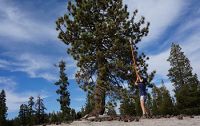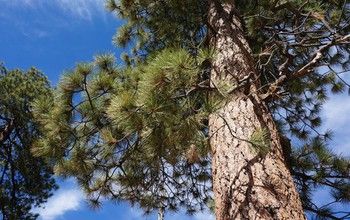NSF News Release: Dust on the wind: Study reveals surprising role of dust in mountain ecosystems
December 6, 2017
Find related stories on NSF's Critical Zone Observatories at this link.
What stories they tell: Jeffrey pine needles have a record of the trees' dust-derived nutrients.
Credit: Lindsay Arvin
Trees growing atop granite in the southern Sierra Nevada Mountains rely on nutrients from windborne dust more than on nutrients from the underlying bedrock.
This surprising finding resulted from a study led by University of Wyoming (UW) scientists. The research was funded by the National Science Foundation (NSF).
A paper reporting the results is published today in the journal Science Advances. Lindsay Arvin of UW is the paper's lead author and co-authors are Cliff Riebe of UW, Sarah Aciego of UW and the University of Michigan (U-M), and Molly Blakowski of U-M.
Arvin, Riebe and colleagues took samples of live pine needles in the Sierra Nevada Mountains. They used two biochemical "fingerprints" in the pine needles to trace the nutrients. "Dust has one fingerprint and bedrock another," Riebe said. "The pine needles showed the degree of mixing of the two."
The results suggest that dust-derived nutrients can be vital to mountain ecosystems, even when nutrient supply from bedrock is substantial.
Riebe said that after making the initial findings, the team then took two datasets -- a global database of erosion rates and a global model of dust inputs -- to look at the effects of dust on nutrients in mountain ecosystems worldwide. The analysis demonstrates that dust can provide a large fraction of a mountain ecosystem's nutrients.
Pine needles revealed how Sierra Nevada conifers use nutrients from windborne dust.
Credit: Lindsay Arvin
"This combination of datasets allowed us to see where dust is important in the world," Riebe said. "One surprising finding is that it may be more critical than previously thought in a lot of places, such as the Appalachian Mountains and Western Europe."
The concept of Earth's "critical zone" -- the swath from the top of the tree canopy down to bedrock -- gives scientists the framework to look at the environment from a larger perspective, said Richard Yuretich, program director for NSF's Critical Zone Observatories Program, which funded the study.
"Researchers can see the global influence of what were thought to be regional processes," said Yuretich." This study shows that dust transported around the world in the atmosphere is an important source of nutrients for plants, even where its contribution isn't obvious. Earth maintains its balance, often in surprising ways."
-NSF-
Media Contacts
Cheryl Dybas, NSF, (703) 292-7734, email: cdybas@nsf.gov
Ron Podell, University of Wyoming, (307) 766-2353, email: rpodell@uwyo.edu
What stories they tell: Jeffrey pine needles have a record of the trees' dust-derived nutrients.
Credit: Lindsay Arvin
Pine needles revealed how Sierra Nevada conifers use nutrients from windborne dust.
Credit: Lindsay Arvin
News Source:
READ MORE from NSF News >>
News Category:
People Involved
CZO
-
Sierra, GRAD STUDENT
-
Sierra, INVESTIGATOR
-
Sierra, COLLABORATOR
Publications
2017
Global patterns of dust and bedrock nutrient supply to montane ecosystems. Arvin, L.J.; Riebe, C.S.; Aciego, S.M.; Blakowski, M.A. (2017): Science Advances, Vol. 3, no. 12, eeao1588
Explore Further






